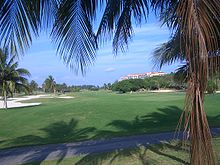Varadero
Varadero is a special area ( Territorio especial ) on the north coast of Cuba on the Hicacos peninsula , a good 120 kilometers east of Havana . It belongs administratively to the municipality of Cárdenas in the province of Matanzas . This is also where the closest point on the main island to the USA is located .
The peninsula, originally inhabited and forested by Indians , was cut down by the Spaniards for shipbuilding, and their caves served as hideaways for pirates . Captains had their ships anchored on these banks for repairs, hence the name Varadero (repair dock). Since 1587, the Varadero saltworks (closed in 1961) supplied large parts of the Spanish Latin American fleet with the necessary salt for the crossing to Europe.

In the 19th century, Cuban hacienda owners began building summer villas on Varadero Beach. The first parcels for holiday homes were approved in 1887 in the area of today's roads 42 to 48. This is where tourism in Varadero began. For the rowing regatta that has been held annually since 1910, the first hotel called “Varadero” (later “Club Nautico”) was built here for members of Cuban society five years later . In the 1920s they were followed by wealthy Americans, first T. Coleman du Pont , great-grandson of Éleuthère Irenée Du Pont de Nemours, the founder of the powder factory and the later DuPont concern , which built a villa east of the village of Varadero and laid out a golf course . Even Al Capone had near the port on the western edge a villa in Varadero (which he did not even inhabited, but used as a depot for contraband), as Cuban President and later dictator Fulgencio Batista .
The first boom in mass tourism began in 1950 and a number of hotels were built. After the revolution of 1959, the land was expropriated and the approximately 20-kilometer-long white, fine sandy beach of Varaderos was opened for public use. The symbol of this new integrated tourism for locals of all walks of life and foreign visitors was the park of the "8000 Taquillas" (Taquilla = changing room), which was built in 1960 and where day trippers could not only store their valuables but also find sanitary facilities, rental of bathing articles and catering facilities. For the first time, the previously marginalized sections of the population, including the women of Varadero, found paid work in the park. The center of the village developed around the park.
In the 1960s to 1980s, Varadero also developed into a center of Cuban music and cultural scene. The central park (8000 taquillas) became the venue for countless concerts and festivals.
Since Cuba's opening to international tourism, Varadero has become the most popular travel destination in Cuba. 4 and 5 star hotels in particular have been built since 1990. For example, the then head of state Fidel Castro personally inaugurated the Hotel Melia Varadero in 1991 . The golf course, which originally belonged to the DuPont villa, has been expanded from nine to eighteen holes.
Along with the upgrading of Varadero as a tourist destination, however, the local population was displaced from key positions in the state and the tourism industry, which were increasingly filled with cadres from other parts of the country. As a result of this process, Varadero has lost much of its cultural and social life as well as its traditions. Facilities such as the central park, the cinema and traditional cultural meeting places were neglected in favor of an all-inclusive tourism limited to the hotel facilities and finally closed. Local events such as the international carnival in January / February, in which foreign visitors and locals had developed joint initiatives since the 1980s, were also carried out.
A curious sight are the land crabs , which are mainly found in the western part .
The ancient and huge cactus "Patriarch" is another attraction.
Varadero today has about 7,000 inhabitants on the Hicacos peninsula and another 13,000 in the incorporated towns of Santa Marta and Boca de Camarioca and is visited by around 500,000 tourists annually. The excessive exploitation and lack of care of natural resources (beach, trees) as well as the loss of the local color mean that visitor numbers are stagnating.
In the vicinity of the city is Cuba's most important international airport next to Havana, the Varadero Airport "Juan Gualberto Gómez" . This was moved about 20 km to the west in the late 1980s / early 1990s because the old airport was reaching its capacity limits; In addition, the spatial proximity to the peninsula resulted in a clear potential for acoustic interference. Parts of the old airport buildings as well as the runway are still there and, as Kawama Airport, are mostly used for tourist flights with older Russian-made aircraft.
Web links
Coordinates: 23 ° 7 ′ N , 81 ° 22 ′ W



